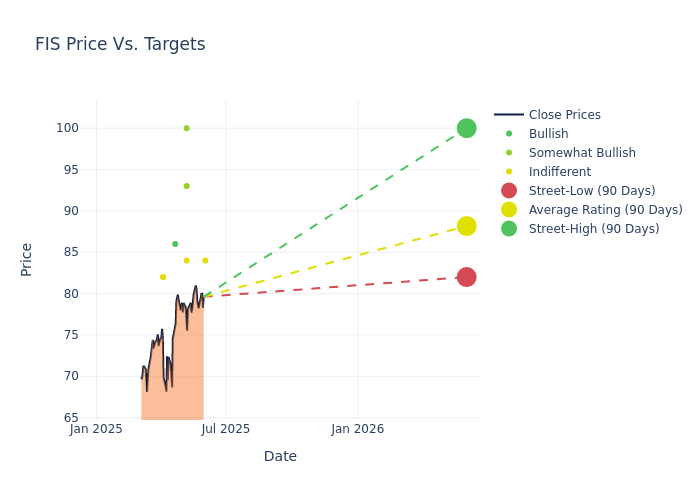What Analysts Are Saying About Fidelity National Info Stock
During the last three months, 6 analysts shared their evaluations of Fidelity National Info (NYSE:FIS), revealing diverse outlooks from bullish to bearish.
The following table provides a quick overview of their recent ratings, highlighting the changing sentiments over the past 30 days and comparing them to the preceding months.
| Bullish | Somewhat Bullish | Indifferent | Somewhat Bearish | Bearish | |
|---|---|---|---|---|---|
| Total Ratings | 1 | 2 | 3 | 0 | 0 |
| Last 30D | 0 | 0 | 1 | 0 | 0 |
| 1M Ago | 0 | 2 | 1 | 0 | 0 |
| 2M Ago | 1 | 0 | 1 | 0 | 0 |
| 3M Ago | 0 | 0 | 0 | 0 | 0 |
Analysts provide deeper insights through their assessments of 12-month price targets, revealing an average target of $88.17, a high estimate of $100.00, and a low estimate of $82.00. This upward trend is evident, with the current average reflecting a 3.73% increase from the previous average price target of $85.00.

Interpreting Analyst Ratings: A Closer Look
The analysis of recent analyst actions sheds light on the perception of Fidelity National Info by financial experts. The following summary presents key analysts, their recent evaluations, and adjustments to ratings and price targets.
| Analyst | Analyst Firm | Action Taken | Rating | Current Price Target | Prior Price Target |
|---|---|---|---|---|---|
| Matthew Coad | Truist Securities | Announces | Hold | $84.00 | - |
| Daniel Perlin | RBC Capital | Lowers | Outperform | $93.00 | $95.00 |
| Charles Nabhan | Stephens & Co. | Raises | Overweight | $100.00 | $90.00 |
| Timothy Chiodo | UBS | Raises | Neutral | $84.00 | $81.00 |
| Ashwin Shirvaikar | Citigroup | Raises | Buy | $86.00 | $79.00 |
| David Koning | Baird | Raises | Neutral | $82.00 | $80.00 |
Key Insights:
- Action Taken: Analysts adapt their recommendations to changing market conditions and company performance. Whether they 'Maintain', 'Raise' or 'Lower' their stance, it reflects their response to recent developments related to Fidelity National Info. This information provides a snapshot of how analysts perceive the current state of the company.
- Rating: Gaining insights, analysts provide qualitative assessments, ranging from 'Outperform' to 'Underperform'. These ratings reflect expectations for the relative performance of Fidelity National Info compared to the broader market.
- Price Targets: Analysts set price targets as an estimate of a stock's future value. Comparing the current and prior price targets provides insight into how analysts' expectations have changed over time. This information can be valuable for investors seeking to understand consensus views on the stock's potential future performance.
Understanding these analyst evaluations alongside key financial indicators can offer valuable insights into Fidelity National Info's market standing. Stay informed and make well-considered decisions with our Ratings Table.
Stay up to date on Fidelity National Info analyst ratings.
Delving into Fidelity National Info's Background
Fidelity National Information Services provides core processing and ancillary services to banks, but its business has expanded over time. By acquiring SunGard in 2015, the company now provides record-keeping and other services to investment firms. With the acquisition of Worldpay in 2019, FIS was providing payment processing services for merchants and holding leading positions in the United States and United Kingdom. But the company sold off a majority interest in Worldpay and now has only a minority stake.
Fidelity National Info's Economic Impact: An Analysis
Market Capitalization: Indicating a reduced size compared to industry averages, the company's market capitalization poses unique challenges.
Revenue Growth: Over the 3M period, Fidelity National Info showcased positive performance, achieving a revenue growth rate of 2.59% as of 31 March, 2025. This reflects a substantial increase in the company's top-line earnings. When compared to others in the Financials sector, the company faces challenges, achieving a growth rate lower than the average among peers.
Net Margin: Fidelity National Info's net margin lags behind industry averages, suggesting challenges in maintaining strong profitability. With a net margin of 3.04%, the company may face hurdles in effective cost management.
Return on Equity (ROE): Fidelity National Info's ROE falls below industry averages, indicating challenges in efficiently using equity capital. With an ROE of 0.5%, the company may face hurdles in generating optimal returns for shareholders.
Return on Assets (ROA): The company's ROA is below industry benchmarks, signaling potential difficulties in efficiently utilizing assets. With an ROA of 0.23%, the company may need to address challenges in generating satisfactory returns from its assets.
Debt Management: Fidelity National Info's debt-to-equity ratio is below the industry average at 0.8, reflecting a lower dependency on debt financing and a more conservative financial approach.
How Are Analyst Ratings Determined?
Within the domain of banking and financial systems, analysts specialize in reporting for specific stocks or defined sectors. Their work involves attending company conference calls and meetings, researching company financial statements, and communicating with insiders to publish "analyst ratings" for stocks. Analysts typically assess and rate each stock once per quarter.
Some analysts publish their predictions for metrics such as growth estimates, earnings, and revenue to provide additional guidance with their ratings. When using analyst ratings, it is important to keep in mind that stock and sector analysts are also human and are only offering their opinions to investors.
Which Stocks Are Analysts Recommending Now?
Benzinga Edge gives you instant access to all major analyst upgrades, downgrades, and price targets. Sort by accuracy, upside potential, and more. Click here to stay ahead of the market.
This article was generated by Benzinga's automated content engine and reviewed by an editor.
 Wall Street Journal
Wall Street Journal